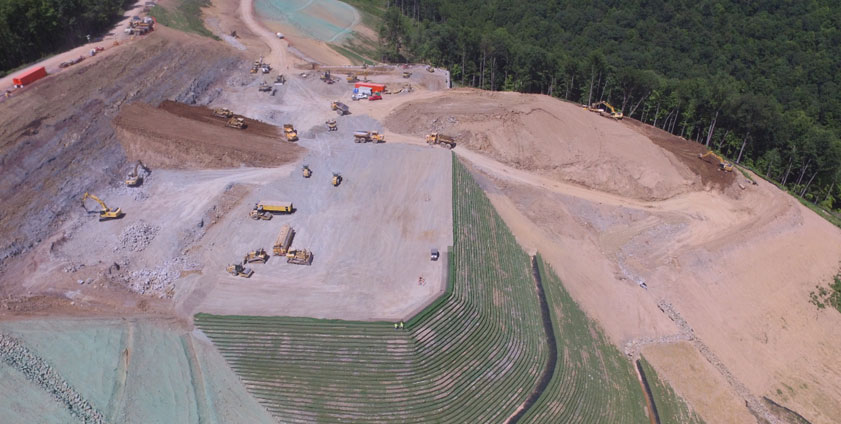Supporting Shale in the Mountain State

Creating a foundation for the Richwood Hill SVC and switching station required several months of blasting, grading and moving 400,000 cubic yards of fill.
April 10, 2019
The discovery of Marcellus Shale gas under the mountains of West Virginia has created an economic boom for the state. As the extraction of gas continues to increase, so does the construction of processing facilities and their associated equipment.
These facilities require massive amounts of electricity to operate, and Mon Power is working hard to enhance and expand its infrastructure so the electricity can be delivered safely and reliably. However, when you are faced with the state’s rocky and unforgiving terrain, constructing new facilities is sometimes easier said than done.
“It’s hard to find a flat piece of land in our service territory,” says Cody Currence, engineer, Planning. “After deciding to build a project, one of the biggest challenges is determining where to put it.”
For example, the static VAR compensator (SVC) and switching station required for the Richwood Hill Transmission Project – constructed in 2016 – were built on the side of a mountain. SVCs provide fast-acting reactive power on high-voltage transmission systems to help regulate voltage and stabilize the electric grid.
When the project first started, the terrain was too steep to walk on, let alone build an electrical facility. It required several months of blasting, grading and moving fill – about 400,000 cubic yards – before the project team had a solid foundation to start erecting equipment.
Thanks to a new 138-kilovolt (kV) transmission line – also part of the Richwood Hill project – the SVC and switching station deliver electricity to a natural gas processing facility located about two miles away. The equipment also enhances service reliability for thousands of Mon Power customers in the area.
Rodney Liston, manager, Customer Accounts, is part of a team that works closely with shale gas developers to assess their current and future needs. As more gas flows from the ground, new production facilities are being built near the wells, often in rugged back-country with few roads and without the necessary infrastructure to deliver an adequate supply of electricity.
“We are performing several distribution system projects designed to fortify our electrical infrastructure to support the shale gas companies operating in our service territory,” said Rodney. “We completed eight projects last year and have seven additional projects scheduled for completion in 2019. This improved infrastructure will not only help gas companies, it will provide enhanced reliability for the region.”
One of the major projects that Rodney and Cody currently are working on is a new 500-kilovolt (kV) substation that will connect to the existing Waldo Run Substation via two 138-kV transmission lines. Although still in the planning phase, Rodney said the facility would be the largest substation built by Mon Power in over a decade.
“The size of the proposed Flint Run Substation shows the massive demand for electricity that has been created by the shale gas industry in our service territory,” he explained. “Although our residential and commercial load growth has remained steady, industrial load growth is expected to increase over the next two years.”
Even with the topographical challenges, Cody is confident we can satisfy the needs of the gas companies. “Mon Power has been building and maintaining electrical equipment in West Virginia for nearly 100 years, so we know how to handle the terrain,” he said. “And, with the projected load growth, we will do what is necessary to get the job done with a strong focus on safety.”